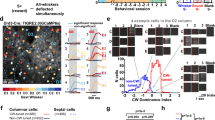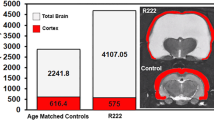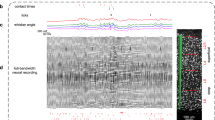Abstract
SENSORY deprivation or deafferentation has been shown to result in a variety of changes within the mammalian central nervous system (CNS)1,2. Although the majority of the studies have been anatomical in nature, recordings from cells in the visual cortex have shown that functional modifications also occur as a consequence of a deprived or abnormal visual experience in early life3–6. Moreover, alterations in neural responses are found in the somatosensory system7–9 following removal of input from the hind leg. We report here functional changes in the rat cortex resulting from early destruction of the whiskers. The region of the rat cortex receiving the sensory input from the whiskers contains aggregations of cells known as barrels and these aggregations do not develop if the corresponding whiskers are destroyed soon after birth10–13. We have found that such whisker removal also causes the associated cortical cells to become functionally reconnected with regions of the face surrounding the whiskers.
This is a preview of subscription content, access via your institution
Access options
Subscribe to this journal
Receive 51 print issues and online access
$199.00 per year
only $3.90 per issue
Buy this article
- Purchase on Springer Link
- Instant access to full article PDF
Prices may be subject to local taxes which are calculated during checkout
Similar content being viewed by others
References
Globus, A. in The Developmental Neuropsychology of Sensory Deprivation (ed. Riesen, A. N.) 9–91 (Academic, New York, 1975).
Smith, D. E. Prog. Neurobiol 8, 349–367 (1977).
Wiesel, T. N. & Hubel, D. H. J. Neurophysiol. 26, 1004–1017 (1963).
Hirsch, H. V. B. & Spinelli, D. N. Science 168, 869–871 (1970).
Blakemore, C. & Cooper, G. F. Nature 228, 477–478 (1970).
Barlow, H. B. Nature 258, 199–204 (1975).
Basbaum, A. I. & Wall, P. D. Brain Res. 116, 181–204 (1976).
Dostrovsky, J. O., Millar, J. & Wall, P. D. Expl. Neurol. 52, 480–495 (1976).
Wall, P. D. & Egger, D. Nature 232, 542–545 (1971).
Woolsey, T. A. & Van der Loos, H. Brain Res. 17, 205–242 (1970).
Welker, C. Brain Res. 26, 259–275 (1971).
Van der Loos, H. & Woolsey, T. A. Science 179, 395–398 (1973).
Van der Loos, H. Phil. Trans. R. Soc. Lond. 278, 373–376 (1977).
Armstrong, J. M. J. Physiol., Lond. 246, 501–538 (1975).
Axelrad, H., Verley, R. & Farkas, E. Neurosci. Lett. 3, 265–274 (1976).
Cragg, B. G. & Waite, P. M. E. Proc. Austr. Physiol. pharmac. Soc. 7, 128P (1976).
Wall, P. D. Phil. Trans. R. Soc. Lond. 278, 361–372 (1977).
Berman, N. & Sterling, P. J. Physiol., Lond. 255, 263–273 (1976).
Goodman, D. C. & Horel, J. A. J. comp. Neurol. 127, 71–88 (1966).
Guillery, R. W. J. comp. Neurol. 146, 407–419 (1972).
Raisman, G. & Field, P. M. Brain Res. 50, 241–264 (1973).
Steward, O., Cotman, C. W. & Lynch, G. S. Expl Brain Res. 20, 45–66 (1974).
Diamond, J., Cooper, E., Turner, C. & Macintyre, L. Science 193, 371–377 (1976).
Kalil, R. Anat. Rec. 175, 353 (1973).
Durham, D. & Woolsey, T. A. Brain Res. 137, 169–174 (1977).
Westrum, L. E. & Black, R. G. Brain Res. 25, 265–287 (1971).
Lund, R. D., Cunningham, T. J. & Lund, J. S. Brain Behaviour Evolution 8, 51–72 (1973).
Lieberman, A. R. in Essays on the Nervous System (eds Bellairs, R. & Gray, E. G.) 71–105 (Clarendon, Oxford, 1974).
Hubel, D. H. & Wiesel, T. N. J. Physiol., Lond. 206, 419–436 (1970).
Author information
Authors and Affiliations
Rights and permissions
About this article
Cite this article
WAITE, P., TAYLOR, P. Removal of whiskers in young rats causes functional changes in cerebral cortex. Nature 274, 600–602 (1978). https://doi.org/10.1038/274600a0
Received:
Accepted:
Issue Date:
DOI: https://doi.org/10.1038/274600a0
This article is cited by
-
Reduction of GABAA receptor binding of [3H]muscimol in the barrel field of mice after peripheral denervation: transient and long-lasting effects
Experimental Brain Research (1994)
-
Single vibrissal cortical column in the mouse labeled with 2-deoxyglucose
Experimental Brain Research (1986)
-
Avoidance of neonatal cortical lesions by developing somatosensory barrels
Nature (1983)
Comments
By submitting a comment you agree to abide by our Terms and Community Guidelines. If you find something abusive or that does not comply with our terms or guidelines please flag it as inappropriate.



